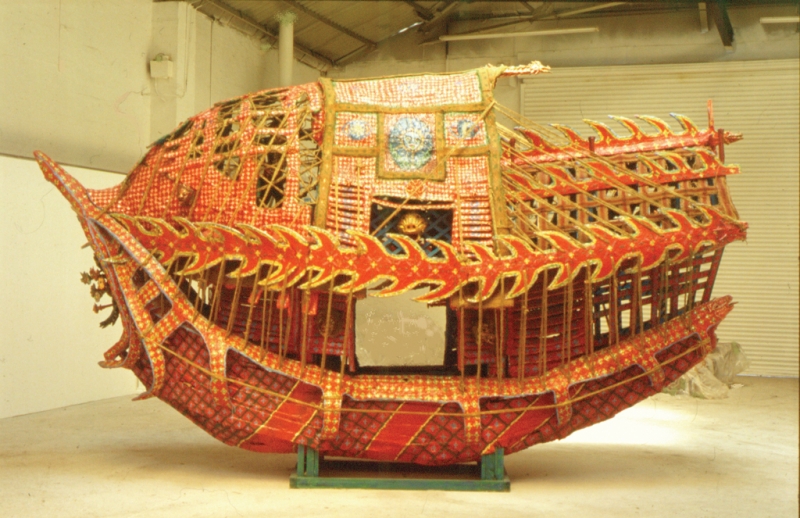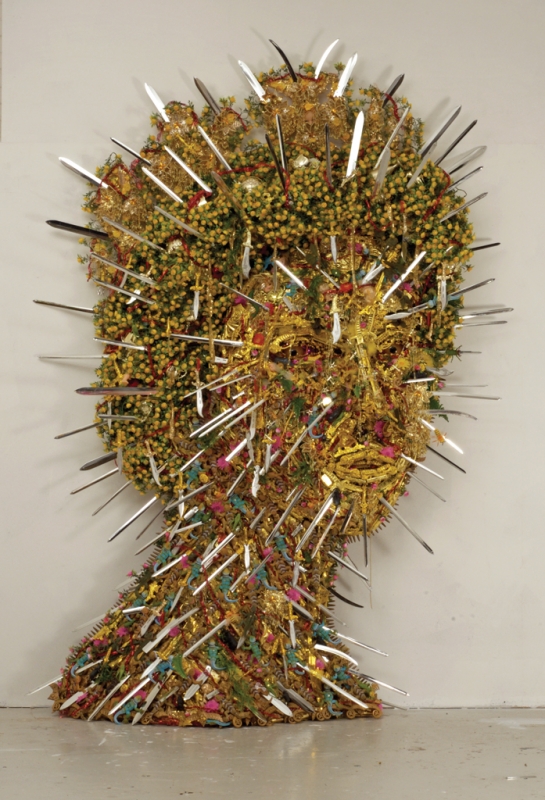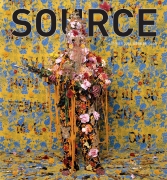How Do You Want Me?
Richard West talks to Hew Locke
Issue 55 Summer 2008
View Contents ▸
View photographs from: How Do You Want Me? ▸
Richard West: When you said you became interested in objects, what was that?
Hew Locke: 'Objects' is the wrong word. I made a flying goat out of cardboard and bamboo and cloth. It was all very carnivalesque, very folk-arty. It was all about trying to get back to a place I'd left long ago in Guyana. I grew up with a collection of outsider art that my dad had. There was one painting that I always remember as a kid: a volcanic landscape with the Queen's head being blown out of a volcano and Prince Phillip standing, looking on at this bizarre scene. Things like that stick in your brain. I was surrounded by this strange imagery and it made sense that I would gravitate towards this kind of thing.
Richard West: Is it a type of Guyanese folk tradition?
Hew Locke: No, it's absolutely not. There is no Guyanese folk tradition that I can think of. There is an Amerindian tradition but there is no folk tradition. And here's where I ran into trouble years later. I would make a sculpture and people would think it was made for some festival. When I was at the Royal College my degree show was this huge papier mâché boat (Ark) and these brightly painted figures. And all the time it was being viewed as something from somewhere else. It was seen as being from a folk tradition, not as being of its own tradition, true to itself as art basically. This problem has dogged me for a number of years.
Richard West: When you finished the Royal College did you feel you'd found a way of working? You were making papier mâché things?
Hew Locke: After doing two years of this I hit a brick wall. It was about people's comments on the work saying, 'Have you ever been to Haiti?' or 'This is like a temple I went to in India'. I stopped making work in colour for three years, I just dropped it. Then, I started making fake Voodoo dolls; basically fake exotica. And that developed into the Voodoo Royal Family. I started having fun with that question that all through the 90s had really annoyed me: 'Where do you come from?' ie. 'You're not one of us. What are you?'
Richard West: If someone was talking about the work as resembling a certain folk tradition why had they got that wrong?
Hew Locke: They had got that wrong because it resembled no folk tradition. Here's the tricky thing, I understood why people were thinking that. This was the time of the phenomenal rise of Camden Market. I always imagined there was this huge underground pipeline. People in India and Africa were taking all this tourist stuff and just funnelling it in, and it was all being vomited out at Camden Lock. So I started writing 'export' on a lot of the work. As in, the work was exported from somewhere else. In the end I took one of these papier mâché figures, sliced it up, packaged it up, cut out these export signs and wrapped it onto a crude wooden base. That was such a release and I never looked back after that. Ark, 1994 4.57m x 1.83m x 3.35m papier-mâché on cardboard on wooden and steel frame, plus mixed media
Ark, 1994 4.57m x 1.83m x 3.35m papier-mâché on cardboard on wooden and steel frame, plus mixed media
Richard West: So the work became parodic of other people's presumptions?
Hew Locke: Yes, and the first one I did, I was terrified. I was thinking, 'I should be modelling this figure'. I went to a close friend in the next studio and said, 'Do you think I'm losing it here?' And he said, 'No Hew, just keep going'. That's what kept me going, the people around me at Gasworks studios. We had artists from all over the world: Cuba, Kenya, South Africa and Japan. We were all in the same boat, at the height of the YBA thing when, in my opinion, Britain couldn't see beyond its shores.
Richard West: What happened between you producing this Voodoo series and producing your latest work?
Hew Locke: I started an examination of what it is to be British. In 1997 my grandmother was dying so we all went up to Kendal in Cumbria. My sister woke me up the next day and, in a very off-hand manner, said, 'I hear Princess Diana died'. I find that these days a lot of people are embarrassed by it. For me it was fascinating. I spent a lot of time going to Kensington Palace and the votive nature of the whole thing had a major impact on me. I remember one piece and I say piece advisedly somebody had found this horrible grotty barbie doll on the street; they'd picked it up, got two pigeon feathers and a bit of tinsel, wrapped it around so it became an angel and strapped it to the railings among all the other nick-nacks. I thought, 'Britain is shifting into this weird thing. Is it a Protestant country? Is it a Catholic country? What's going on here?' To this day I remember the reek of the flowers. It took years for this to come out in the work; there was this shrine-like Voodoo thing going on and that's how the work became what it became, out of this experience.
Richard West: So what were you making?
Hew Locke: I was making large portraits of the Queen out of plastic toys, covered in swords and little insects. All cheap stuff. It was about making icons out of an unfashionable icon.
Richard West: What was the transitional stage for you to start photographing?
Hew Locke: The transitional stage was that I found the work wasn't saying enough. It wasn't getting out an anger I had been feeling for years. I got make up, shades, crappy bits of material and asked some people to take digital shots of me to see how this worked. I was having problems with people liking what I was doing. It's nice when they like what you are doing, but this was liking it in a way that was becoming too comfortable, too easy, and I wanted to challenge the audience a bit more. I felt I really needed to put myself in the work. I had got to the stage I was making nice objects. Even if they were creepy, they were attractive objects, because my interest is in beauty, a broken kind of beauty.
Richard West: How did the new work come about after you had taken the original digital pictures?
Hew Locke: I wanted these photographs to be big. That meant they had to be large format photographs. So the first thing in the project was, 'How can I get the money?' So I spent some time on an application to the Arts Council with the help of my wife, Indra. Then practical things: I couldn't take these photographs myself. I did several lessons in large format photography back in the 80s but I realised that'd be too much for me; the costumes would be too complicated, it would be impossible. To cut a long story short, we started quite simply with me sitting in a chair in a costume against a white backdrop and then added more and more bits until at the end of the day we had a photograph. Then I started setting up backdrops and making simple props and something that was deliberately messy; deconstructing the whole thing to show that it was actually in my studio. This then developed into larger sets so you wouldn't necessarily know where it was.
Richard West: How did you make them from the inside? How did you make them while inhabiting them?
Hew Locke: In practical terms what I did was make a wooden framework and hang a costume on it in front of the backdrop. The costume and the backdrop were built together. I was literally making a piece of work that had no hands or eyes, but I knew the hands and eyes and feet would be me. Being inside the costume was strange as well. Because I had made the costume and I knew the backdrop I could direct what was going on, even though I couldn't see it myself. People would hold up mirrors to me, the photographer would take a polaroid and I'd say, 'Is the chain around my foot OK?' And the photographer would say, 'If you go back then we can have the background not blown out so much'. It became a mix between technical stuff and me directing things saying, 'How does that pose look?' El Dorado, 2005 290 x 175 x 60 wood and cardboard base, screws, mixed media (plastic, fabric) Courtesy of the West Collection, Philadelphia
El Dorado, 2005 290 x 175 x 60 wood and cardboard base, screws, mixed media (plastic, fabric) Courtesy of the West Collection, Philadelphia
Richard West: What was a good effect?
Hew Locke: A good effect was drama. Quite often it was gunmen, taken from all those news images of guys spouting their demands against a backdrop. But it was more about a state of being becoming something other than myself. It's not posing for a photograph, it was 'I am this thing and I believe it.'
There is one called Serpent of the Nile. It was the last one I made. I'm sitting in a big dress against a yellow background. I've got chains hanging from my hands and I've got this coat of arms behind me. The feeling was, 'I've got the money, I've got the power, look at it. This may be a flimsy set up I've got here but this is real'. It is an intense feeling. I'm not Hew walking down the road. I'm not Hew sitting down talking to you. I've become this ruler, this dictator, this person with power.
Richard West: It's almost something monstrous?
Hew Locke: Yes, It was about bringing out a darker side of myself. I needed to do these photographs to get across an anger.
Richard West: Does it help that you're masked?
Hew Locke: Absolutely. And in a way it is a response to a lot of portrait photography that has become almost a cliché. I wanted to do something where you may not see the eyes, but you see the hands and realise there's a person in there.
Richard West: The pictures are lavish. Could you talk about some of the extravagance.
Hew Locke: I like colour. I like a baroque sensibility. These figures are covered in flowers, dolls' parts, swords, and all this on top of boiler suits which are covered in cloth which I bought in stores in the States and Trinidad. Basically, I build up a collection of brightly coloured weirdness. It is following on from the work I'd done before, even from the days of the Voodoo dolls. It is the same thing but made in a different way.
Richard West: Do all the objects in the pictures have a particular relevance to you?
Hew Locke: No, they have a generalised relevance. I forgot to say that when I did the Voodoo dolls they were based around stories in the press about child soldiers in Sierra Leone who were waving around British weapons that had been sent to the army. The babies, the doll parts, refer to this ongoing interest I have. The characters I'm portraying hark back to the guy behind the scenes pulling the strings. On one coat there's stars and badges which loosely refer to that type of paraphanalia on generals: where you can't even see their uniforms because they're covered in medals.
Richard West: Are there references to people you would see in the street?
Hew Locke: There are Brixton street characters. They are not as extravagant as Guyanese street characters but there are one or two people that I have noticed in Brixton over the years like this Rasta guy in bright yellow robes, standing looking flamboyant and disapproving of us mere mortals who are sinning all the time. I went to this folk festival in Viana do Castelo in Portugal where there is a parade of eligible young women from the area. They walk around in traditional costumes with hands on hips and they are wearing their dowry, which is endless gold: gold chains, gold chains all over the place. It's a kind of hereditary bling. That experience of seeing those girls had a real impact. These were modern women, no doubt studying at university, but this was their price.
The title is about authenticity as well. People want the real contemporary Indian art, the real contemporary Brazilian art. My question is 'what kind of authenticity do you want from me?' Because this is a mongrel art, this ain't got pedigree at all. It is coming out of a Guyanese, West Indian mindset, but coming out of a British mindset as well. It doesn't have a comfortable place to sit. By putting this costume on, it's a way of talking about the Caribbean. It says 'Look at me. This is who I am. You don't really know who I am'.
Other articles by Richard West:
Source Photo: Do we need Photography Galleries? [Blog Post] ▸
Source Photo: The New Photo Galleries: A US Perspective [Blog Post] ▸
Source Photo: List Mania: 2011 Photobook Roundup [Blog Post] ▸
Source Photo: Is There a Crisis in Art Book Publishing? [Blog Post] ▸
Source Photo: Charlotte Cotton Resigns Media Museum [Blog Post] ▸
Issue 52: Teenage Girls at the Edges of Cities at Night... [Feature] ▸
Other articles mentioning Hew Locke:






